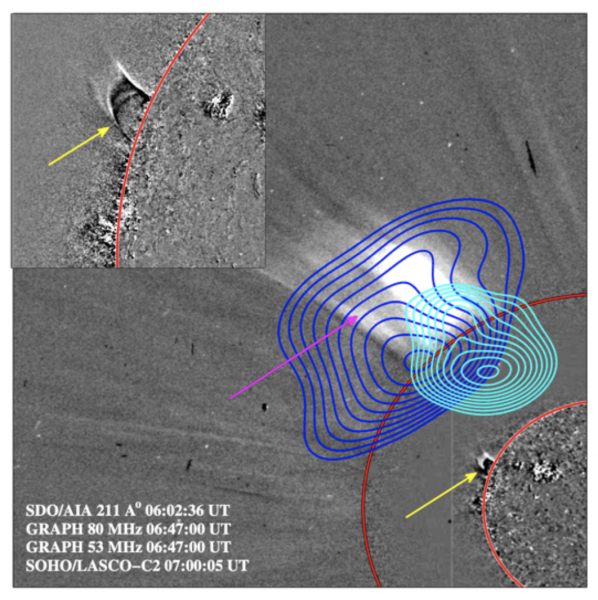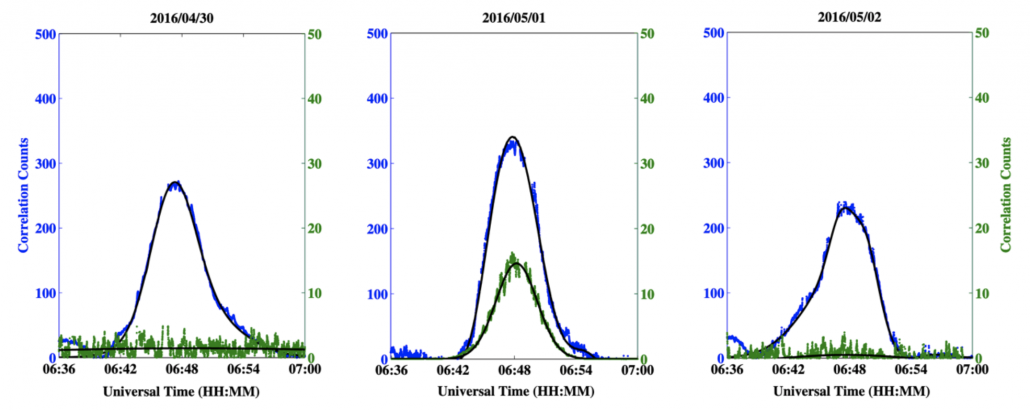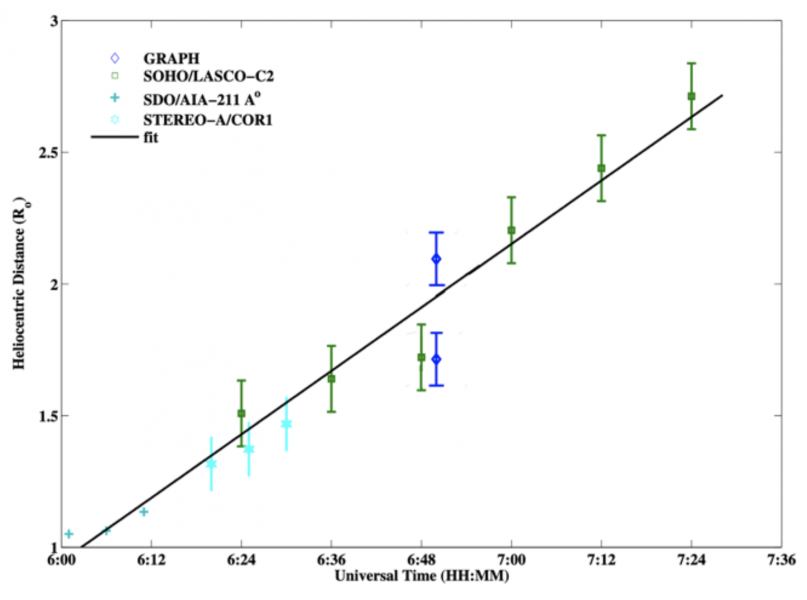Coronal mass ejections (CMEs) are large scale and energetic eruptions in the solar atmosphere during which $\approx$10$^{12}$-10$^{16}$g of magnetized coronal plasma are ejected into the heliosphere at speeds ranging from $\approx$100-3000km/s. They are mostly observed in whitelight using coronagraphs which use an occulter to block the bright light from the solar photosphere so that structures like CMEs can be observed with better contrast. But the size of the coronagraph occulters till date has always been larger than that of the photosphere. This prevents observations of the corona present immediately off the solar limb, in addition to the corona above the solar disk. Radio observations are unique in this connection since there is no occulter, hence both ‘limb’ and ‘disk’ corona could be observed simultaneously. However, there are only a few reports of direct detection of CMEs at radio frequencies via thermal bremsstrahlung emission (see for example, Sheridan et. al. 1978, Gopalswamy et. al. 1992, Kathiravan et. al. 2005, Ramesh et. al. 2003). We studied the radio observations of thermal emission from a CME simultaneously at two different frequencies on 2016 May 1.
Observations and Analysis
The radio observations were carried out on 2016 May 1 using the different facilities operated by Indian Institute of Astrophysics (IIA) in Gauribidanur observatory. Observations in Extreme ultraviolet (EUV) at 211 A$^o$ with the Atmospheric Imaging Assembly (AIA; Lemen et. al. 2012) on board the Solar Dynamics Observatory (SDO), and in whitelight with the COR1 coronoagraph of the Sun-Earth Connection Coronal and Heliospheric Investigation (SECCHI; Howard et. at. 2008) on board the Solar TErrestrial RElationship Observatory (STEREO) and the Large Angle and Spectrometric Coronagraph (LASCO; Brueckner et. al. 1995) on board the Solar and Heliospheric Observatory (SOHO) were used to supplement the radio observations. The spatio-temporal correspondence between the radio contours and the whitelight CME (Figure 1) indicates that the radio emission could be due to the CME. The larger size of the radio contours, particularly at 53 MHz and in the north-south direction, are likely due to the comparatively limited angular resolution of GRAPH. The centroids of the radio emission are located at $r_{80}{\approx}$1.7$\pm 0.2\rm R_{\odot}$ (80 MHz) and $r_{53}{\approx}$2.1$\pm0.2\rm R_{\odot}$ (53 MHz). Any possible error in the position of the centroids due to propagation effects such as scattering by density inhomogeneities in the solar corona and/or refraction in the Earth’s ionosphere.

Figure 1 – A composite of the difference images obtained using EUV ($\approx$06:02-05:41 UT), radio ($\approx$06:47-06:42 UT), for 80 MHz contours in ‘cyan’ and $\approx$06:47-06:43 UT and whitelight ($\approx$07:00-06:00 UT) observations on 2016 May 1. The inner and outer ‘red’ circles indicate the solar limb (radius$\approx$1$\rm R_{\odot} $), and the occulter in the SOHO/LASCO-C2 coronagraph (radius$\approx$2.2$\rm R_{\odot} $). The bright emission above the occulter (indicated by ‘magenta’ arrow) is the whitelight CME. The inset in the upper left corner is a close-up view of the region indicated by the ‘yellow’ arrow on the SDO/AIA-211 A$^o$ image. The ‘cyan’ and ‘blue’ contours correspond to radio observations at 80 MHz and 53 MHz. The contour levels are ${\approx} $[63, 67, 71, 75, 79, 83, 87, 91, 95, 99] \% of $3.4{\times}10^{5}$K (80 MHz) and $0.8{\times}10^{5}$K (53 MHz).
The brightness temperatures ($T_{b}$) of the radio sources near their centroids are $T_{b}^{80} {\approx}3.4{\times}10^{5}$K (80 MHz) and $T_{b}^{53} {\approx}0.8{\times}10^{5}$K (53 MHz). The corresponding flux density ($S$) values are $S_{80} {\approx}0.14$sfu (80 MHz) and $S_{53} {\approx}0.06$sfu (53 MHz). The spectral index ($\alpha$) derived from the above flux densities is ${\approx}2.1$. Model calculations by Bastian et. al. 1997 also indicate that it is possible to observe enhanced thermal emission from particularly the off-limb CMEs using difference images as in the present case. The above $T_{b}$ values are reasonably consistent with those predicted by the aforementioned model for thermal emission from a ‘typical’ CME in the same frequency range.
 Figure 2 – Polarimetric GRIP observations of Stokes I (‘blue’) and V (‘green’) emission at 80 MHz in the transit mode around 06:48 UT. The asymmetry in the Stokes I observations on 2016 May 2 was due to a local radio frequency interference (RFI) around ${\approx}$06:40 UT. The `solid’ lines in black colour are the `fit’ to the respective data points.
Figure 2 – Polarimetric GRIP observations of Stokes I (‘blue’) and V (‘green’) emission at 80 MHz in the transit mode around 06:48 UT. The asymmetry in the Stokes I observations on 2016 May 2 was due to a local radio frequency interference (RFI) around ${\approx}$06:40 UT. The `solid’ lines in black colour are the `fit’ to the respective data points.
Results and Conclusions
The separation between the centroids of the 80 MHz and 53 MHz radio sources (Figure1) suggests possible density gradient in the frontal structure similar to that in the background corona since it is well known that radio emission from the Sun at a particular frequency ($f$) can propagate towards the observer only from/above the critical level at which the plasma frequency ($f_{p}$) corresponding to the local electron density ($N_{e}$) equals $f$. It is known that the larger density gradient near the solar limb leads to refraction of low frequency radio waves. So, the contribution to observed thermal bremsstrahlung emission at any given frequency is primarily from regions well above the corresponding plasma level. This implies smaller optical depth ($\tau$) since the absorption coefficient and hence $\tau$ are maximum only near the plasma level (Smerd 1950, Aubier et. al. 1971). In the case of solar corona, $T_{b}$ and $\tau$ are related to its electron temperature ($T_{e}{\approx}10^{6}$K) as $T_{b}{\approx}T_{e}(1{-}e^{-\tau})$. Since $\tau$ above the limb is small as mentioned, $T_{b}{<}T_{e}$ although the spectral index could be indicative of optically thick thermal emission. The emission from CMEs too undergoes refraction and reflection near the plasma layer as described above (Bastian et. al. 1997). The fact that $T_{b}^{80}$ and $T_{b}^{53}$ in the present case are lesser than $T_{e}$ also indicates the same.
Using the aforementioned relation, we calculated $\tau$ corresponding to $T_{b}^{80}$ and $T_{b}^{53}$, and the values are ${\tau}_{80}{\approx}$0.4 and ${\tau}_{53}{\approx}$0.1. Based on this, we then estimated $N_{e}$ at $r_{80}{\approx}$1.7$\pm0.2\rm R_{\odot}$ and $r_{53} {\approx}$2.1$\pm0.2\rm R_{\odot}$ to be $N_{e}^{80} {\approx} $2.2$\rm{\times }10^{7} cm^{-3}$ and $ N_{e}^{53} {\approx}$1.0$\rm {\times} 10^{6}cm^{-3}$, respectively. We calculated the CME kinetic energy $E_{cme}^{radio}{\approx}2{\times}10^{30}$erg. The estimates of $M_{cme}^{radio}$ and $E_{cme}^{radio}$ agree reasonably with the mass and kinetic energy of the CME estimated using SOHO/LASCO-C2 observations. The density at $r{\approx}$2.1$\rm R_{\odot}$ is ${\approx}1.0{\times}10^{6}\rm cm^{-3}$ and the estimated $dcp$ due to CME associated enhanced radio emission is ${\approx}12\%$. Sastry (2009) had shown that if $B{\approx}$0.5G and electron density is ${\approx} 1.2{\times}10^{6}\rm cm^{-3}$, then it should be possible to observe circular polarized radio emission with $dcp{\approx}$12 %.

Figure 3. CME h-t plot obtained using EUV, whitelight and radio observations.
In this study, we reported relatively rare observation of CME in low radio frequencies on 2016 May 1. No non-thermal radio burst activity was noticed, which provided an opportunity to observe the faint thermal radio emission from the CME, and hence we directly estimated the electron density, mass, and magnetic field strength of the plasma entrained in the CME. Future observations with low frequency radio antenna arrays with larger collecting area like LOFAR and SKA should be able to effectively exploit this possibility for CMEs against the solar disk also.
Based on the recent paper: Ramesh, R., Kumari, A., et. al.: New results on the direct observations of thermal radio emission from a solar coronal mass ejection. Geophysical Research Letters, 48, e2020GL091048, DOI: https://doi.org/10.1029/2020GL091048
References
Sheridan, K. V., & McLean, D. J. (1985). Solar radiophysics: Study of emission from the sun at meter wavelength (pp. 443–466).
Gopalswamy, N., & Kundu, M. R. (1992). The Astrophysical Journal, 390, L37–L39.
Bastian, T. S., & Gary, D. E. (1997). Journal of Geophysical Research, 102, 14031–14040.
Sastry, C. V. (2009). The Astrophysical Journal, 697, 1934–1939.
*Full list of Authors: R. Ramesh, Anshu Kumari, C. Kathiravan, D. Ketaki, T. J. Wang.
